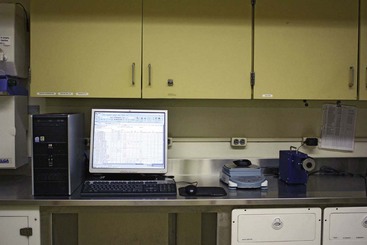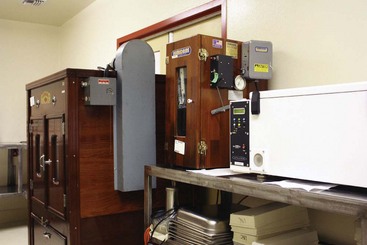Chapter 42 Prehatch Protocols to Improve Hatchability
Artificial incubation of avian eggs is a valuable tool that has facilitated breeding programs for numerous species. Removing eggs for artificial incubation frequently leads to double or triple clutching, thereby increasing the fecundity of a pair in any given season. Management of artificial incubation focuses on minimizing contamination and using best practice incubation conditions to maximize hatchability. This involves developing protocols for sanitation, incubation, egg management, record keeping, and egg necropsy. An overview of these topics will be covered in this chapter. An understanding of avian egg and embryo development is important when working with artificial incubation techniques. There are several comprehensive works on avian development.6,7,19,20
Facilities and Equipment
Commonly used incubators have automated turning systems that rotate eggs every 1 to 2 hours. Embryonic development may be improved by hand turning three times a day to ensure that an egg has been turned completely, because some automatic turners do not roll an egg over completely. Studies have shown that some of the smaller eggs, such as most passerine species, may benefit from more turning than larger eggs, such as ratite eggs.3 Fig. 42-1 shows several types of incubators within the incubation room at the author’s facility.
Hatchers are similar to incubators, but without turners. Incubators may be used as hatchers, although it is not recommended to do so at the same time as the eggs are being incubated because of the increased risk of contamination. Hatchers are typically set at 0.5° F to 1° F (0.27° C to 0.55° C) lower than the temperature used for incubation. A candler is used for evaluating egg condition at the start of incubation and monitoring the development of the circulatory system throughout incubation. High-quality scales are necessary for accurate and precise monitoring of egg weights. Otherwise, errors may be introduced into calculations of egg weight loss. A more in-depth discussion of incubation equipment has been covered by others.12
Egg Management and Record Keeping
A first step in egg management is to decide which species are candidates for artificial incubation. If possible, take measures to ensure a clean nest environment. Personnel should ensure that their hands are washed or wear examination gloves when handling eggs. Egg collection may occur before or after incubation has started. Eggs may benefit from partial parental incubation. Once incubation has started, eggs may be transported in a small cooler containing clean warm (95° F [35° C]) millet deep enough to cover at least half of the egg. Millet is readily available, is clean, and functions as a shock absorber when moving eggs from the nest to the incubator. Other systems for egg collection have also been used.1 Anything that may absorb moisture also increases the risk of contamination.
When feasible, choose eggs for incubation that have no evidence of heavy contamination or trauma. Genetic importance of an egg or a poor parental history will sometimes necessitate incubating eggs in less than ideal conditions. Gross contamination may be removed by gently wiping away debris with a soft clean or sterile cloth. Fine sandpaper may be used to remove buildup of dried debris, but care must be taken to preserve the cuticle. Several methods for repairing damaged eggs have been described.12 Candling eggs prior to being set for incubation allows documentation of conditions and developmental stage. Additionally, this may be done daily as long as safe techniques are used, such as not holding an egg up to a hot lamp for more than a few seconds at a time. If an embryo is determined to have died, it should be removed from the incubator as soon as possible to avoid contamination. Eggs may be weighed daily or biweekly to determine the percentage of egg weight loss. An example of how record keeping, egg weighing, and candling equipment are set-up in a clean environmental space at the author’s facility is shown in Fig. 42-2.

Figure 42-2 Examples of record keeping, egg weighing, and candling equipment at the author’s facility.
It is a common practice in commercial poultry operations to use egg dips, washes, or fumigation to reduce external egg contamination. These processes need to be carefully monitored because the dip or wash solution needs to be warmer than the egg or the solution and surface bacteria will be drawn into the egg as it cools. Also, some solutions may damage the protective cuticle layer of the egg. One epidemiology study evaluating hatchability in broiler breeder flocks in a number of poultry operations has found that those not using any egg disinfection had better results than those using dips, sprays, or formalin fumigation.9
Formaldehyde fumigation of freshly laid eggs is no longer used at our facility because of regulations and human health hazards. Dips and sprays are generally not recommended for most exotic eggs because of a lack of information regarding their safety. Spot-cleaning soiled eggs with liquids is not recommended. In situations in which infections have been documented, dips may be appropriate for thick-shelled eggs. A fine mist of a phenolic or quaternary ammonium disinfectant applied to moist or contaminated eggs is used in the ostrich industry.23
A new technique recently evaluated for the poultry industry uses electrolyzed oxidizing (EO) water spray on eggs to reduce microbial contamination.5 The authors of this study concluded that the use of EO water reduces microbial contamination without affecting hatchability of the eggs. This could prove to be an option for nondomestic operations in the future.
Treating potentially infected eggs during incubation has been reported. Piperacillin has been injected into the air cell of psittacine eggs at days 14, 18, and 22 (4.0 mg for macaw eggs and 2.0 mg for cockatoos or smaller) to improve hatchability.16 Tylosin (0.5 to 1.0 mg) injected into the air cell at the start of incubation has been used to treat Mycoplasma infections in eggs.17 Others have studied the effects of gentamicin injection (0.2 mg) into the albumen of chicken eggs at 15 days of incubation.2 There was no adverse effect on hatchability of treated eggs versus control eggs. Despite gentamicin levels being below the limit of detection in yolks and embryos, hatchability was significantly improved in the gentamicin-treated eggs. Dipping eggs into antibiotic solutions has also been used to treat infected eggs.
Stay updated, free articles. Join our Telegram channel

Full access? Get Clinical Tree



